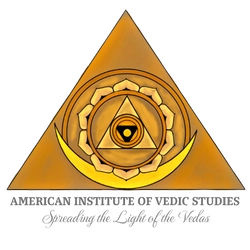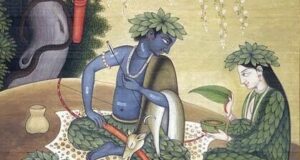The Sun is not merely an outer power but an inner energy source, reflecting the supreme light of Consciousness in Yoga both in our own hearts and in the universe around us. Meditating on the solar deity in his many forms is particularly important to understand on the summer solstice and International Yoga Day.

The Sun is the most powerful influence in nature, responsible for the light from which all life functions, and sustaining the force of gravity by which the earth revolves. The Sun is the ruler of our solar system and all that occurs within it. Yet though we may welcome the sunlight every day, we seldom consider the yogic reality of the Sun or honor the sacred presence and higher Self-awareness behind it.
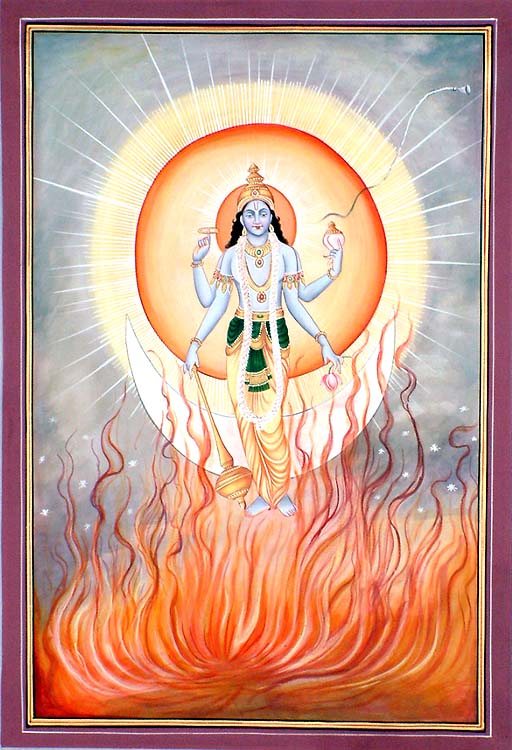
Yoga of the Sun and Vedic Dharma
If we look at traditional cultures worldwide, we note a strong awareness of the Sun as the doorway to a higher cosmic reality. Extensive religious, yogic, astrological, mystical and shamanic traditions revere the Sun and the wisdom and power behind it, the Sun as reflecting the higher light behind all existence.
The Vedic Yoga is a “Yoga of light,” which is a “Solar Yoga” or “Yoga of the Sun.” Vedic Dharma is probably our best preserved ancient system of the original religion of light and the Sun.
The Sun is the visible representation of the Divine, the very face of the Gods. The Sun is the symbol of the Self, spirit and Divine presence (Atman), our own highest light and immortal Self.
The bright face of the Gods has arisen, the eye of Mitra, Varuna, and Agni. He has filled heaven, earth, and the atmosphere, the Sun, the Self (Atman) of all that is stable and moving.
Kutsa Angirasa, Rigveda I.115.1
The Sun is no mere material globe, but the source of life, intelligence, love, and consciousness. We are all rays of the central Sun of consciousness that illumines the entire world. Throughout the ancient world, we find a worship of the Sun as part of a greater religion and spiritual path of light, enlightenment, and Self-realization. This “solar religion” or “Solar Dharma” occurs along with the sacred Fire, the mystic Moon, and other aspects of light – part of a worship of nature and of the cosmic mind behind it.
Ancient Solar Religions and Yoga
The Sun is the Supreme Deity, the Light of lights, the God of gods of the ancient world. This religion of the Sun pervaded the ancient world, including the Egyptians, Persians, Hindus, and Scythians, and to the Aztecs, Mayas, Incas, and Pueblo Indians of the Americas. Ancient European traditions of the Greeks, Romans, Celts, Germans, and Slavs, are similarly rooted in the Sun. There is a strong solar symbolism in Zoroastrianism, Buddhism, and Shinto. Such spiritual teachings regard us as “children of the Sun,” forms of light on Earth taking birth to fulfill the solar will towards greater consciousness and Self-realization.
The natural religion of our species is the religion of the Sun as part of recognizing the power of Universal Consciusness. Yoga was first taught to humanity by the Sun God in various names and forms as the Bhagavad Gita states. The ancient solar religion of humanity reflects its original Yoga tradition.
Earlier humanity was more spiritual owing to its ability to connect with the Divine light behind the Sun. This ancient path of solar light beckons us from the future and the past, as the ecological age dawning today requires we once more honor the sacred and Divine presence in nature and the Sun.
Vedic Religion of the Sun and Light (Surya Dharma)
The Vedas are based upon a solar symbolism. The Sun is the supreme deity of the Vedas, the Divine power in heaven, which functions in the atmosphere as Lightning, and on earth as Fire, which are the three main manifestations of light in our visible world. The Vedic ritual involves offerings to the sacred fire in order to connect us with the powers of the solar deity. The Vedas teach that we are children of the Sun born on earth to carry forward the Divine light of truth.
The Vedic Yoga involves resurrecting the Sun out of darkness, which means returning to the Sun of our own true Self that is hidden in the darkness of the material world and the ego-mind. Each one of us is a Sun, a portion of the universal light of consciousness. That solar aspect of our being must be regained through the process of Yoga Sadhana, a cultivation of the light within us.
Chanting mantras in the sunlight, particularly standing in water and offering mantras to the solar deity, is one of the most powerful Mantra Yoga practices, with solar mantras like Oṁ, Hrīṁ, or the Gayatri Mantra. Sound is also light and we can use the Sun to energize all mantras. Hrīm (Hreem) is the most important of the bija mantras carrying the power of the Sun. But the solar energy is the root of all mantras. Vedic mantras are said to dwell in the rays of the Sun. They number 432,000, which is 360 X 1200, reflecting a solar mathematics.
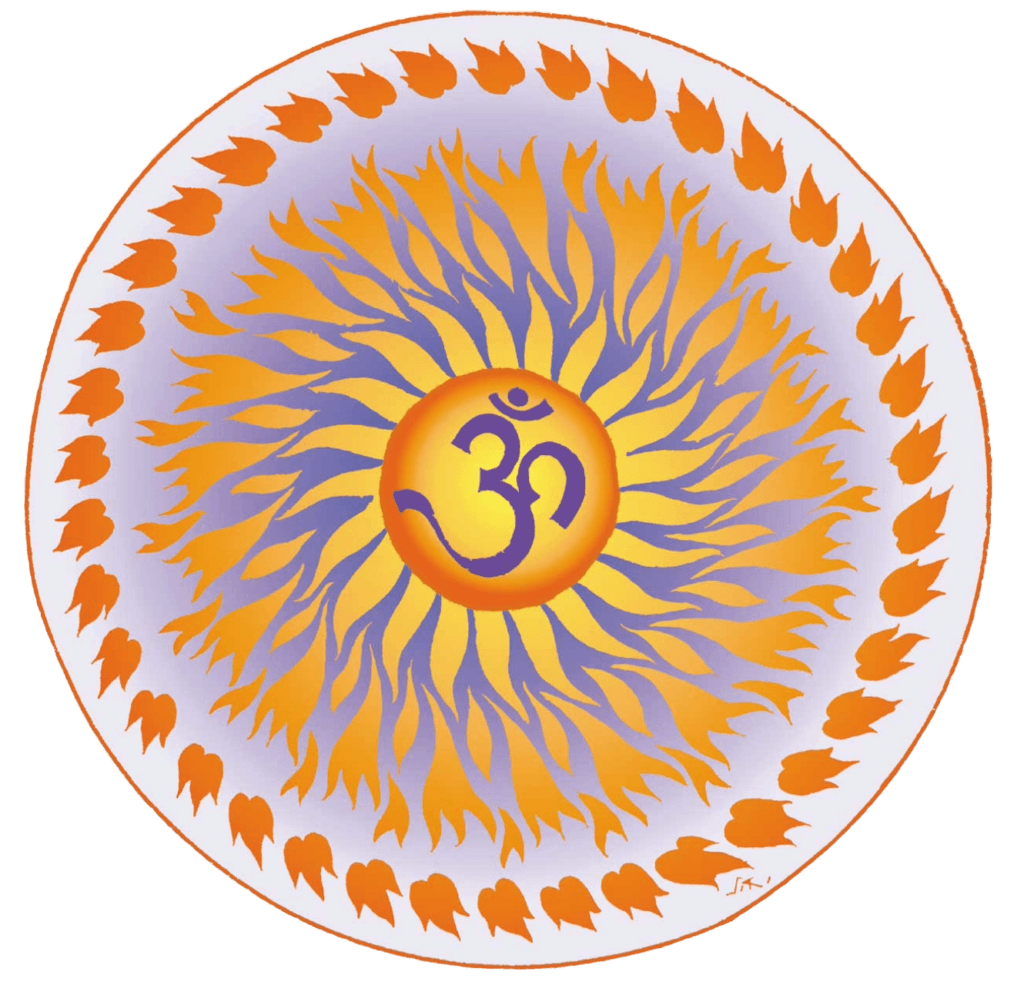
Gayatri Mantra
The Gayatri Mantra to Savita, a powerful form of the Sun God, is the most important of all Vedic mantras, and one of the most commonly used in Yoga practices. The Gayatri Mantra is an important tool for drawing the spiritual energy of the Sun into our minds, hearts and bodies, serving, chanted at sunrise, noon and sunset.
We meditate upon the supreme light of the Divine transforming Sun (Savita) that he may stimulate our intelligence. Gathina Vishvamitra, Rigveda III.62.10
Savita (Savitr.) represents the Divine light of awareness hidden within us that Yoga activates to bring about the evolution of our consciousness beyond time and mortality.
There are many Gayatri based hymns in the Vedas, as Gayatri also refers to one of the three main Vedic meters in which more than 200 mantric hymns are composed. Another Gayatri Mantra of Vishvamitra occurs in the Rigveda as before the more famous Gayatri Mantra. It lauds the Sun as Pushan, the power of perception, which serves to nourish us from within.
Who discerns and sees together all the worlds, may that nourishing Sun (Pushan) be our protector. Gathina Vishvamitra, Rigveda III.62.9
Another Gayatri brings in Aditi, the Divine Mother and a seeking of bliss and happiness. Aditi is the great World Mother and all the Sun Gods called Adityas are regarded as her children.
Sinless before the infinite Mother (Aditi), in the impulse of the Divine Solar father (Savita), may we meditate upon all things as beautiful. Shyavashva Atreya, Rigveda V.82.6
The deity of the Gayatri Mantra, Savita, represents the transformational power in the Sun, not only to change night into day, but also to take us beyond the darkness of the ego into the infinite light of the higher Self. Savita is the deity of Yoga and meditation, who sets the yogic process in motion within us as a manifestation of the Divine Will.
Purusha/Our Higher Self as the Being in the Sun
Yoga and the Vedas are linked together by the Purusha or Atman, the Supreme or Universal Self, which is the goal of Yoga and the main subject of the Upanishadic teachings. The Purusha/Atman is identified with the Sun in Vedic and Yogic thought. The idea of union with the Sun occurs in several Vedic verses, to quote a few examples below.
I have known that Supreme Person, of the luster of the Sun beyond darkness. Only knowing him can one go beyond death. There is no other path for transcendence. Shukla Yajurveda XXXI.18, Shvetashvatara Upanishad III.8
Arising from the surrounding darkness, seeing the higher light, we have reached the Godhead, the Divine Sun, the supreme light. Praskanva Kanva, Rigveda I.50.10
From my father, I have received the wisdom of truth. I was born even as the Sun. Vatsa Kanva, Rigveda VIII.6.10
The great Upanishadic prayer is to merge into the Solar Self. The famous Isha Upanishad ends with a chant to merge in the solar Self, which also contains the oldest reference to the So’ham mantra. In fact, the great Hamsa or Swan of yogic thought is originally a Vedic Sunbird.
Sun, O nourisher, single seer, controller, power of the Lord of creation, remove your rays and gather up your heat that I may see your most auspicious form. The Purusha (Person) that is within the Sun beyond, He am I! Isha Upanishad 16
The Upanishads tell us that the Sun chants Oṁ as it moves in the sky. The Sun is not only the source of light, but also that of sound and mantra. Mantra Yoga is rooted in the worship of the Sun.
Thus indeed that which is the upward chant (udgītha), that is the primal sound (praṇava). That which is the primal sound that is the upward chant. That which is the Sun beyond is the upward chant. He is primal sound. He chants Oṁ as it moves. Chandogya Upanishad I.5.1
The Sun and the Branches of Yoga
In the Yoga of Knowledge, the inner Self or Atman is symbolized as the Sun, ever shining in the hearts of all. After introducing the mantra “I am Brahman” (aham Brahmāsmi) or “I am God,” the Upanishads quote a verse from the Rishi Vamadeva in the Rigveda that states, “I was Manu and the Sun.”
Relative to the Yoga of Devotion or Bhakti Yoga, the first and main images used in worship were that of the deity in the Sun disc, Surya-Narayana. This is the background of the ancient Vaikhanasa tradition of India, which is still followed in the famous temple of Tirupati in South India.
A solar symbolism enters into the great trinity of Hindu deities. Brahma, the Creator, has a solar aspect. Vishnu, the preserver, is worshipped as the Sun, particularly as Surya-Narayana, the Sun as the cosmic person who enters into the hearts of all beings. Shiva, the transformer, is honored as the supreme deity behind the Sun, particularly as Rudra, who represents the highest light and color of the Sun. Brahma, Vishnu, and Shiva are identified with the three aspects of solar energy as creating, sustaining, and transforming the universe.
Solar Yoga and Solar Yogis
Krishna in the Bhagavad Gita states he taught the original Yoga first to Vivasvan, the Sun God, who passed it on to Manu. Krishna is the Yogavatara or “incarnation of Yoga,” a status that is not afforded to any other human personage.
Manu, the son of the Sun, is the first king, law giver and great Yogi in this particular world-age/yuga From him originate both the great dynasties of Vedic kings, with Rama as the form of Vishnu relating to the Sun. The Buddhists honor the Sun Buddha.
The traditional founder of Yoga Darshana or the “Yoga system of philosophy” – which the Yoga Sutras of Patanjali represents – is Hiranyagarbha, which means the “Golden Embryo,” identified with the Sun. Kapila, the founder of the Samkhya system, is also identified with the Sun.
Yajnavalkya is an important figure in Vedanta and Yoga, the most famous Upanishadic sage behind the Brihadaranayaka, the longest of the ten classical Upanishads. He received his Vedic mantras directly from the Sun God as Aditya. The Yogi Yajnavalkya, an ancient Yoga text of great renown, reflects a strong solar symbolism.
Sun and Prana
The Sun as Prana is a key to many pranayama practices. In the Upanishads, the Sun is identified with Prana:
The Self bears itself in two ways, as Prana and as the Sun. Such are his two paths, outer and inner, which revolve by day and by night. The Sun is the outer Self and Prana is the inner Self. The movements of the inner Self (Prana) are measured by those of the outer Self (the Sun). Maitrayani Upanishad VI.1-3
Our prana is our inner Sun that follows a similar course as the outer days and nights.
Yajnavalkya’s Shatapatha Brahmana states we have 10,800 breaths by day and night. This equals 720 breaths every 48 minutes (1/30 of a day), which he identifies with the days and nights in a year. It amounts to one breath every four seconds.
In the subtle body, the right/solar (Pingala) nadi governs fire, heat, and activity at a physiological level. The Sun is present as the solar plexus fire in Hatha Yoga.The key to pranayama is to draw in the prana of both the inner and the outer Suns.
The Sun and Meditation
One of the most important meditation techniques is to meditate upon the Supreme Self as the Sun within the heart, of which the mind and brain is an outer reflection like the Moon.
Relative to modern Yoga masters, Sri Aurobindo taught an integral Yoga of Self transformation through the Supramental light and Shakti, which he lauds under the symbolism of the Sun. Ramana Maharshi, the greatest of the Jnana Yogis, speaks of the heart and the Self as the inner Sun.
In Tantric Yoga, the Sun is also identified with the heart. The spiritual fire force of Shakti in the root chakra and the lunar or water force (Soma) of Shiva in the crown chakra unite in order to create it. Agni is the red point, drop or sphere (bindu), and Soma is the white bindu, which unite to create the Sun as the golden bindu.
Names of the Sun God
The Sun God has the largest number of names of any Vedic deity, reflecting different aspects of light, transformation, or Dharma.
- Sūrya – the one who sets everything in motion; the most common name for the Sun.
- Savita – the power of inspiration, motivation, and higher evolution, Yoga and meditation.
- Āditya – the unbounded light and primal intelligence.
- Mitra – the Divine friend and lord of compassion .
- Varuṇa – the Divine lord, giver of wideness.
- Āryaman – the Divine companion, friend, and helper is the third after Mitra and Varuna, and together rule the three higher heavens or rochanas beyond the ordinary three realms of earth, atmosphere, and heaven.
- Bhaga – the blissful lord, Bhagavan.
- Puṣan – the nourisher, the seer, the guide of the soul beyond death and darkness.
- Viṣṇu – the pervader, ruler of the highest heaven.
- Tvaṣṭaṛ – the maker of forms, associated with the great Goddesses.
- Hiraṇyagarbha – the golden seed or fetus; the causal body.
- Indra – Indra as the Supreme Lord is often a name for the Sun or higher light, though more commonly he relates to the atmosphere.
- Vivasvān – the radiant one, associated with the dawn.
- Prajāpati – the lord of creatures, more common in later Vedic texts.
Vedic Surya Yoga
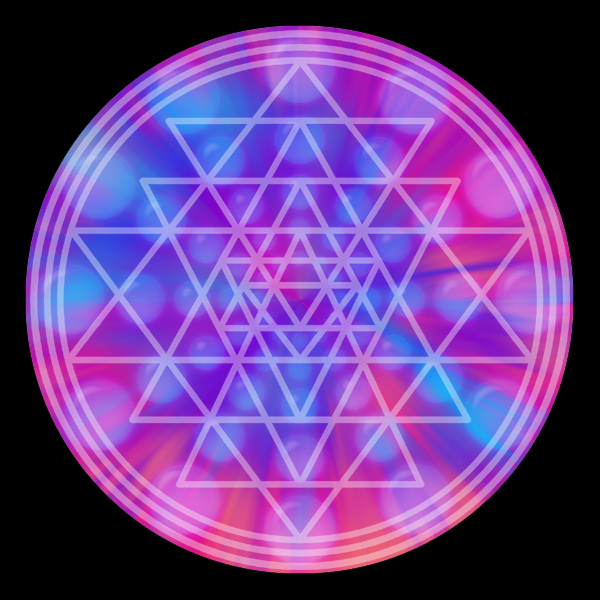
Surya Dhi (solar intelligence) is the illuminating power of our higher intelligence. Surya Yoga is the culmination of the Dhi Yoga, the union with our higher Self that, like the Sun, is pure light. Here, yoking is done of the mind, manas, and Dhi, powers of intelligence by the Divine Sun or Atman as Savita.
Seers of the vast illumined seers yoke their intelligences and their mind. The one knower of the ways of wisdom ordains the invocation. Great is the glory of the Divine creative Sun. Shyavashva Atreya, Rigveda V.81.1, Shvetashvatara Upanishad II.4, Shukla Yajurveda XI.4
This Sun God is the Creator and Lord of all the worlds, the Sun of suns, the God of Gods, the Light of lights. There are various forms of Yoga connected with the Vedic Sun Gods, seven or twelve Sun Gods or Adityas as representing the seven rays of the Sun or the twelve months of the year.
The Sun Gods uphold the stable and moving world. They are the guardians of all the universe. With a profound intelligence (dīrghā dhiyo), guarding their celestial powers, the carriers of truth, they note our debts. Gritsamada Shaunaka, Rigveda II.27.4
The rising of the Sun every day indicates our own deeper light, purity and Self-realization.
When rising today, you declare the truth to Mitra and Varuna that we are sinless, may we abide in the unbounded Godhead, O Aryaman, your beloved singers. Maitravaruni Vasishtha, Rigveda VII.60.1
